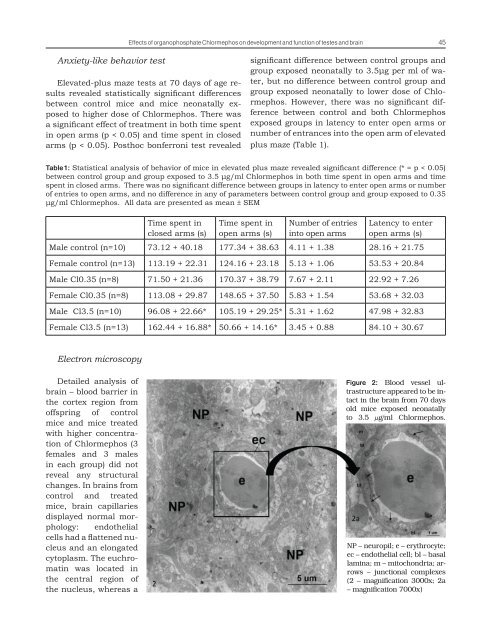SLOVENIAN VETERINARY RESEARCH
SLOVENIAN VETERINARY RESEARCH
SLOVENIAN VETERINARY RESEARCH
You also want an ePaper? Increase the reach of your titles
YUMPU automatically turns print PDFs into web optimized ePapers that Google loves.
Effects of organophosphate Chlormephos on development and function of testes and brain 45<br />
Anxiety-like behavior test<br />
Elevated-plus maze tests at 70 days of age results<br />
revealed statistically significant differences<br />
between control mice and mice neonatally exposed<br />
to higher dose of Chlormephos. There was<br />
a significant effect of treatment in both time spent<br />
in open arms (p < 0.05) and time spent in closed<br />
arms (p < 0.05). Posthoc bonferroni test revealed<br />
significant difference between control groups and<br />
group exposed neonatally to 3.5μg per ml of water,<br />
but no difference between control group and<br />
group exposed neonatally to lower dose of Chlormephos.<br />
However, there was no significant difference<br />
between control and both Chlormephos<br />
exposed groups in latency to enter open arms or<br />
number of entrances into the open arm of elevated<br />
plus maze (Table 1).<br />
Table1: Statistical analysis of behavior of mice in elevated plus maze revealed significant difference (* = p < 0.05)<br />
between control group and group exposed to 3.5 μg/ml Chlormephos in both time spent in open arms and time<br />
spent in closed arms. There was no significant difference between groups in latency to enter open arms or number<br />
of entries to open arms, and no difference in any of parameters between control group and group exposed to 0.35<br />
μg/ml Chlormephos. All data are presented as mean ± SEM<br />
Time spent in<br />
closed arms (s)<br />
Time spent in<br />
open arms (s)<br />
Number of entries<br />
into open arms<br />
Latency to enter<br />
open arms (s)<br />
Male control (n=10) 73.12 + 40.18 177.34 + 38.63 4.11 + 1.38 28.16 + 21.75<br />
Female control (n=13) 113.19 + 22.31 124.16 + 23.18 5.13 + 1.06 53.53 + 20.84<br />
Male Cl0.35 (n=8) 71.50 + 21.36 170.37 + 38.79 7.67 + 2.11 22.92 + 7.26<br />
Female Cl0.35 (n=8) 113.08 + 29.87 148.65 + 37.50 5.83 + 1.54 53.68 + 32.03<br />
Male Cl3.5 (n=10) 96.08 + 22.66* 105.19 + 29.25* 5.31 + 1.62 47.98 + 32.83<br />
Female Cl3.5 (n=13) 162.44 + 16.88* 50.66 + 14.16* 3.45 + 0.88 84.10 + 30.67<br />
Electron microscopy<br />
Detailed analysis of<br />
brain – blood barrier in<br />
the cortex region from<br />
offspring of control<br />
mice and mice treated<br />
with higher concentration<br />
of Chlormephos (3<br />
females and 3 males<br />
in each group) did not<br />
reveal any structural<br />
changes. In brains from<br />
control and treated<br />
mice, brain capillaries<br />
displayed normal morphology:<br />
endothelial<br />
cells had a flattened nucleus<br />
and an elongated<br />
cytoplasm. The euchromatin<br />
was located in<br />
the central region of<br />
the nucleus, whereas a<br />
Figure 2: Blood vessel ultrastructure<br />
appeared to be intact<br />
in the brain from 70 days<br />
old mice exposed neonatally<br />
to 3.5 μg/ml Chlormephos.<br />
NP – neuropil; e – erythrocyte;<br />
ec – endothelial cell; bl – basal<br />
lamina; m – mitochondria; arrows<br />
– junctional complexes<br />
(2 – magnification 3000x; 2a<br />
– magnification 7000x)
















